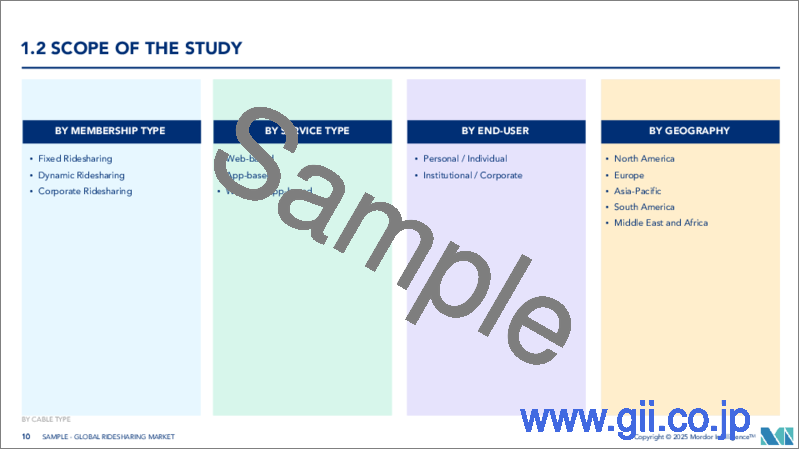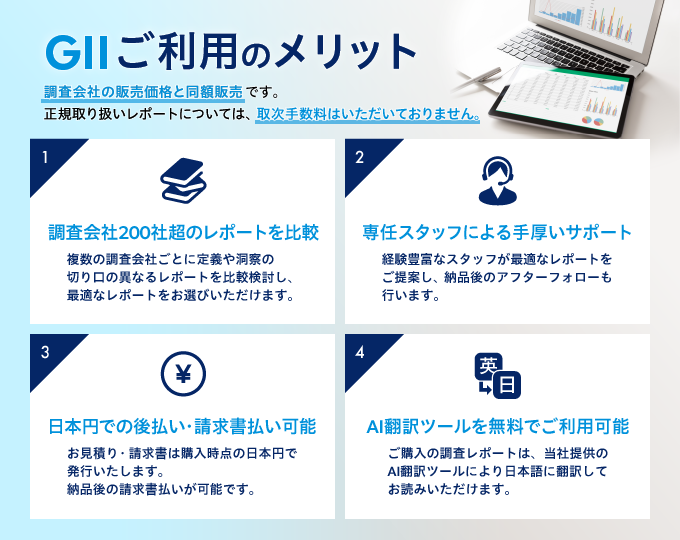|
|
市場調査レポート
商品コード
1640691
ライドシェアリング:世界の市場シェア分析、産業動向と統計、成長予測(2025年~2030年)Global Ridesharing - Market Share Analysis, Industry Trends & Statistics, Growth Forecasts (2025 - 2030) |
||||||
カスタマイズ可能
適宜更新あり
|
|||||||
| ライドシェアリング:世界の市場シェア分析、産業動向と統計、成長予測(2025年~2030年) |
|
出版日: 2025年01月05日
発行: Mordor Intelligence
ページ情報: 英文 127 Pages
納期: 2~3営業日
|
全表示
- 概要
- 目次
世界のライドシェアリングの市場規模は2025年に530億2,000万米ドルと推定され、予測期間(2025~2030年)のCAGRは11.45%で、2030年には911億6,000万米ドルに達すると予測されます。

ライドシェアリング市場の成長を後押ししているのは、車両所有コストの上昇、交通量の減少を促す環境問題、ライドシェアリングを提唱する政府規制など、いくつかの要因です。これらの要因は、ライドシェアリング導入の世界的急増の重要な促進要因です。これらのサービスは費用対効果の高さで支持されており、手頃な価格の自動車保有をしのぐと予想されています。
主なハイライト
- 過去10年間で、ライドシェアリングは世界の動向として台頭し、多くの個人が従来のタクシーサービスよりもライドシェアリングを選んでいます。一般的に、ライドシェアリング会社はGPS追跡を利用して、潜在的な乗客とドライバーをモバイル・アプリケーションやウェブサイト経由で結びつけています。ライドシェアリング企業は、従来のタクシーサービスとは異なり、標準的な免許や規制の義務を回避することができます。自動車保有台数の減少、インターネットやスマートフォンの普及率の上昇、厳しいCO2削減目標といった要因が、ライドシェアリングサービスの需要上昇を後押ししています。
- また、通勤者数の増加もライドシェアリングサービスの需要を後押ししています。例えば、米国国勢調査局によると、2022年には米国で約1億4,000万人が日常的に通勤しています。さらに、Move in Syncによると、Employee Commute India 2023レポートでは、ムンバイが従業員の帰社率をリードし、2022年12月には大流行前のレベルを上回ったと述べています。ムンバイに続き、首都圏(NCR)の帰社率は92%、バンガロールは85%、ハイデラバードは81%だった。このような膨大な数の通勤・帰宅者が市場の成長を牽引すると思われます。
- 世界的には、スマートフォンやスマート・ウェアラブルを含むスマートデバイスの普及が急増しており、インターネット・データの利用が増加していることも、ライドシェアリング・サービスの成長に拍車をかけています。乗り合い輸送サービスへのアクセスは、インターネット接続に依存しています。ユーザーはインターネット対応のスマートフォンアプリケーションを活用して情報を収集し、乗り物をナビゲートします。V2V通信、ナビゲーション、テレマティクスは、最適なパフォーマンスのためにこの接続性に依存しています。スマートフォンアプリケーションは、ドライバーの名前、番号、写真、車両識別、ルートトレース、過去の乗車記録などの機能を提供し、セキュリティを強化します。
- 著名な市場で事業を展開するサービス・プロバイダーやアプリケーション・ベンダーの数が増加しているため、ベンダーは長期的に持続可能でない可能性のある損失で消費者にメリットを提供せざるを得ない競争空間が形成されています。サービス・プロバイダーが、提供するサービスの価格を引き上げることで収益性を高める方向に事業計画を転換すれば、消費者は、競争力のある価格で同様のサービスを提供する新規参入企業に乗り換えるかもしれないです。このようなシナリオは、サービス・プロバイダーの成長に課題となっています。
- 堅調な経済成長期には、可処分所得の増加がライドシェアリング需要を押し上げることが多く、個人は利便性に対価を支払う傾向が強くなります。逆に、雇用率が高まれば、ライドシェアリングに参加できる、または参加する意思のある個人が少なくなるため、ドライバーの供給が逼迫する可能性があります。多国籍ライドシェアリング企業にとっては、為替レートの変動が収益性を左右する可能性があります。特に不利な為替変動が価格の引き上げにつながる場合は、多様な市場における価格戦略が需要を形成する上で極めて重要です。
ライドシェアリング市場の動向
アプリベースのサービスが市場シェアの大半を占める
- アプリベースのライドシェアリングサービスは、ユーザーがスマートフォンやタブレット端末にダウンロードするモバイルアプリを通じて運営されます。これらのアプリを使えば、ユーザーはリアルタイムでライドシェアリングを予約し、ドライバーを追跡し、アプリのインターフェイス内で支払いを管理することができます。このサービスは、乗客と自家用車を利用するドライバーを結びつけ、従来のタクシーや公共交通機関に代わる選択肢を提供します。ウェブベースのサービスとは異なり、アプリベースのプラットフォームはモバイルテクノロジーに特化しており、よりシームレスでユーザーフレンドリーな体験を提供します。
- アプリケーションベースのライドシェアリングサービスは、スマートフォンの普及率の増加、モバイル技術の進歩、消費者の嗜好の変化など、いくつかの要因によって、過去10年間で大きく成長しました。エリクソンによると、2023年の世界のスマートフォンモバイルネットワーク契約数は約70億件で、2028年には77億件を突破すると推定されています。これらのアプリが提供する利便性と使いやすさは、特に迅速で信頼性の高い交通機関への需要が高い都市部での普及につながっています。
- モバイル・アプリケーションは、情報を修正するための合理的なソリューションです。ユーザーが移動時間、日付、ピックアップポイント、目的地などの必要な詳細を入力する必要がある場合、モバイルアプリは、ユーザーが好みを設定し、個人アカウントを作成し、重要な情報を手元に置いておくことができるため、大きな追加機能として機能する可能性があります。
- 北米や欧州などの新興国市場では、スマートフォンの所有率が高く、インターネットインフラがしっかりしているため、アプリケーションベースのライドシェアリングサービスの成長が後押しされています。これらの地域の消費者は、これらのプラットフォームが提供する効率性とカスタマイズ性を高く評価しており、多くの場合、乗車スケジュール、料金見積もり、エコノミーカーからプレミアムカーまで複数の車両オプションなどの機能が含まれています。これらの市場は、ライドシェアリング・サービスをより広範な交通エコシステムに統合することを支援する強力な規制枠組みから恩恵を受けています。
大きな成長を遂げるアジア太平洋地域
- 中国、インド、東南アジア諸国などの経済成長が可処分所得を押し上げ、より多くの人々がライドシェアリング・サービスを利用できるようになった。環境の持続可能性に対する意識の高まりや交通渋滞を緩和する必要性から、自家用車の所有に代わる実行可能な選択肢としてライドシェアリングを支持する動きが消費者にも政府にも広がっています。
- この地域で事業を展開する企業はまた、二輪車が一般的な国で二輪車ライドシェアリングのオプションを提供するなど、地域の嗜好に合わせてサービスを調整しています。戦略的パートナーシップや先端技術への投資と組み合わされたこのような地域密着型のアプローチが、アジア太平洋全域でのライドシェアリング市場の拡大を牽引し続けています。
- 2024年8月、シンガポールのモビリティとクイック・コマースの分野で極めて重要な技術企業であるRyde Group Ltdは、現地の主要な金融サービス・プロバイダーであるSinglifeとパートナーシップを結びました。この提携は、ライドシェアリングの安全対策を強化し、ライダーとドライバーのパートナー双方に比類のない保険を提供することを目的としています。シングライフ社との提携を通じて、ライドグループは利用者への価値提案を強化するだけでなく、あらゆる旅の安心を保証します。
- 日本政府は2024年4月1日から、ライドシェアリングサービスの禁止措置を大幅に解除し、タクシー会社がタクシー不足の地域や時間帯でライドシェアリングサービスを運営できるようにしました。解禁は、政府が2023年12月20日にデジタル行財政改革中間報告(中間報告)を採択したことを受けたもの。
ライドシェアリング業界の概要
ライドシェアリング市場には、世界プレーヤーと多数の中小企業が混在しています。主なプレーヤーには、OmniRide(ポトマック・ラッパハノック交通委員会傘下)、Kangaride、Planete Covoiturage Inc./CarpoolWorld Inc.、Via Transportation Inc.、Ridesharing.com(COVOITURAGE MONTREAL Inc.傘下)などがあります。製品ラインナップを強化し、持続的な競合優位性を確保するため、これらのプレーヤーはパートナーシップや買収などの戦略をますます重視するようになっています。
2024年7月:画期的な動きとして、ロレイン郡交通局はTransitTechのリーダーであるViaと提携し、最先端のオンデマンド公共交通サービス「Via LC」を開始しました。7月15日、ViaLCはロレインとエリリアの住民の交通に革命を起こす計画で、ボタンひとつで簡単に乗車予約ができます。ロレイン郡交通局と手を組むことで、ViaLCはより広範な公共交通ネットワークへの地域社会のアクセスを大幅に強化します。住民は、ViaLCモバイルアプリを使ってロレインまたはエリリア市内の乗車予約を便利に行うことができ、また、長距離移動の際にはロレイン郡交通局のバスに簡単に乗り換えることができます。
2024年6月トリニティ・メトロはTransitTechプロバイダーのViaと共同で、タラント郡に革新的な公共交通機関の新時代を切り開きます。オンデマンド・ライドシェアリングサービス「ZIPZONE」の成功で知られるViaは、トリニティメトロの野心的なビジョンの中核を担う。この協力関係の深化により、トリニティ・メトロは、交通ネットワーク全体に先進技術を導入し、運行を最適化することを目指しています。
その他の特典
- エクセル形式の市場予測(ME)シート
- 3ヶ月間のアナリスト・サポート
目次
第1章 イントロダクション
- 調査の前提条件と市場定義
- 調査範囲
第2章 調査手法
第3章 エグゼクティブサマリー
第4章 市場洞察
- 市場概要
- 業界の魅力度-ポーターのファイブフォース分析
- 供給企業の交渉力
- 消費者の交渉力
- 新規参入業者の脅威
- 代替品の脅威
- 競争企業間の敵対関係の強さ
- 産業バリューチェーン分析
- マクロ経済動向の市場への影響
- 技術開発
第5章 市場力学
- 市場促進要因
- カープール/企業プールサービスのコスト優位性と利用可能性の増加
- 主要市場の政府によるインセンティブとリベート
- 自動車保有コストの上昇と環境面のメリット
- 市場の課題
- ラストワンマイル接続への懸念と業界のダイナミックな性質、ライドヘイリングベンダーの増加が既存事業者の課題となっています。
- 市場機会
- カーシェアリング規制のパラメーター
- ビジネス/収益モデルの使用事例
第6章 市場セグメンテーション
- メンバーシップタイプ別
- 固定ライドシェアリング
- ダイナミックライドシェアリング
- 法人ライドシェアリング
- サービスタイプ別
- ウェブベース
- アプリベース
- ウェブおよびアプリベース
- 地域別
- 北米
- 欧州
- アジア
- オーストラリア・ニュージーランド
- ラテンアメリカ
- 中東・アフリカ
第7章 競合情勢
- 企業プロファイル
- OmniRide(Potomac and Rappahannock Transportation Commission)
- Kangaride
- Plante Covoiturage Inc./CarpoolWorld Inc.
- Via Transportation Inc.
- Ridesharing.com(COVOITURAGEMONTREAL Inc.)
- Scoop Commute Inc.(Spacer Technologies)
- BlaBlaCar(Comuto SA)
- KINTO Join Limited(TOYOTA MOTOR CORPORATION)
- GoMore ApS
- Hitch Technologies Inc.
- Liftshare(Mobilityways Limited)
- gobyRIDE(RideShark Corporation)
- Sameride LLC
- Carma Technology Corporation
- Enterprise Holdings Inc.
- ライドシェアビジネスモデルにおけるベンダーの市場ポジショニング
第8章 投資分析
第9章 市場の将来
The Global Ridesharing Market size is estimated at USD 53.02 billion in 2025, and is expected to reach USD 91.16 billion by 2030, at a CAGR of 11.45% during the forecast period (2025-2030).

Several factors drive the growth of the ride sharing market, such as rising vehicle ownership costs, environmental concerns prompting a reduction in traffic, and government regulations advocating for ride sharing. These factors are critical drivers of the global surge in ride sharing adoption. These services are favored for their cost-effectiveness and are also anticipated to outpace affordable car ownership.
Key Highlights
- Over the past decade, ride sharing has emerged as a global trend, with many individuals opting for it over conventional taxi services. Typically, ride sharing firms utilize GPS tracking to connect potential passengers with drivers via mobile applications or websites. Ride sharing companies can bypass standard licensing and regulatory mandates, unlike traditional taxi services. Factors such as declining car ownership, increasing internet and smartphone penetration, and stringent CO2 reduction targets collectively drive the rising demand for ride sharing services.
- The rise in the number of people commuting to work also propels the demand for ride sharing services. For instance, according to the US Census Bureau, almost 140 million people in the United States routinely commuted to work in 2022. Further, according to Move in Sync, the Employee Commute India 2023 report stated that Mumbai led the way in employee returns to the office, surpassing pre-pandemic levels in December 2022. Following Mumbai, the National Capital Region (NCR) saw a return rate of 92%, Bangalore at 85%, and Hyderabad at 81%. Such a huge number of people commuting and returning to offices would drive the market's growth.
- Globally, the surge in smart device adoption encompassing smartphones and smart wearables coupled with heightened internet data usage has catalyzed the growth of ride sharing services. Accessing ride transport services hinges on internet connectivity. Users leverage internet-enabled smartphone applications to gather information and navigate their rides. V2V communication, navigation, and telematics rely on this connectivity for optimal performance. Smartphone applications bolster security, offering features like driver's name, number, photograph, vehicle identification, route tracing, and historical ride records.
- There is an increase in the number of service providers and application vendors operating in prominent markets, thus creating a competitive space where vendors are forced to offer benefits to consumers at a loss that may not be sustainable over a long period. Once the service provider switches the business plan to turn toward profitability by increasing the prices of the services offered, consumers may switch to newer players offering similar services at competitive prices. Such scenarios are challenging the growth of service providers.
- During robust economic growth, rising disposable incomes often boost ride sharing demand, with individuals more inclined to pay for convenience. Conversely, high employment rates can tighten the supply of drivers, as fewer individuals are available or willing to participate in ridesharing. For multinational ride sharing firms, fluctuating exchange rates can sway profitability. Pricing strategies across diverse markets are crucial in shaping demand, especially if unfavorable currency shifts lead to price hikes.
Ridesharing Market Trends
App-based Services Hold Major Market Share
- Application-based ridesharing services operate through mobile applications that users download onto their smartphones or tablets. These apps allow users to book rides in real time, track their drivers, and manage payments within the app's interface. The service connects passengers with drivers using personal vehicles, offering an alternative to traditional taxis and public transport. Unlike web-based services, application-based platforms focus entirely on mobile technology, providing a more seamless and user-friendly experience.
- Application-based ridesharing services have grown significantly over the past decade, driven by several factors, including increased smartphone penetration, advancements in mobile technology, and changing consumer preferences. According to Ericsson, in 2023, the global smartphone mobile network subscriptions totaled nearly 7 billion and are estimated to surpass 7.7 billion by 2028. The convenience and ease of use offered by these apps have led to widespread adoption, particularly in urban areas where demand for quick and reliable transportation is high.
- A mobile application is a reasonable solution for modifying information. When a user needs to enter required details such as time of travel, date, pick-up point, and destination, a mobile app may work as a great addition as it allows users to set preferences, create personal accounts, and keep vital information at hand.
- In developed markets such as North America and Europe, the growth of application-based ridesharing services is bolstered by a high level of smartphone ownership and robust internet infrastructure. Consumers in these regions value the efficiency and customization offered by these platforms, which often include features like ride scheduling, fare estimates, and multiple vehicle options, ranging from economy to premium cars. These markets benefit from strong regulatory frameworks that support the integration of ridesharing services into the broader transportation ecosystem.
Asia-Pacific to Register Major Growth
- Economic growth in countries like China, India, and Southeast Asian nations has boosted disposable incomes, enabling more people to afford ridesharing services. The increasing awareness of environmental sustainability and the need to reduce traffic congestion have encouraged both consumers and governments to support ridesharing as a viable alternative to private car ownership.
- Companies operating in the region are also tailoring their offerings to meet local preferences, such as providing two-wheeler ridesharing options in countries where motorcycles are more common. This localized approach, combined with strategic partnerships and investment in advanced technologies, continues to drive the expansion of the ridesharing market across Asia-Pacific.
- In August 2024, Ryde Group Ltd, a tech firm pivotal in Singapore's mobility and quick commerce landscape, entered a partnership with Singlife, a key local financial services provider. This collaboration aims to enhance safety measures in ridesharing and offer unparalleled insurance coverage to both riders and driver-partners. Through this alliance with Singlife, Ryde Group not only boosts the value proposition for its users but also ensures peace of mind for every journey.
- The Japanese government lifted significant parts of its ban on ride-sharing services beginning April 1, 2024, allowing taxi companies to operate these services in areas and at times in which taxis are in short supply. The lifting of the ban follows the government's adoption on December 20, 2023, of the Digital Administrative and Financial Reform Interim Report (Interim Report).
Ridesharing Industry Overview
The ride sharing market showcases a blend of global players and numerous small-to-medium-sized enterprises. Key players include OmniRide (affiliated with the Potomac and Rappahannock Transportation Commission), Kangaride, Planete Covoiturage Inc./CarpoolWorld Inc., Via Transportation Inc., and Ridesharing.com (linked to COVOITURAGE MONTREAL Inc.). To bolster their product offerings and secure a lasting competitive edge, these players are increasingly turning to strategies like partnerships and acquisitions.
July 2024: In a groundbreaking move, Lorain County Transit, in partnership with TransitTech leader Via, launched "Via LC," a cutting-edge on-demand public transit service. Beginning July 15, ViaLC planned to revolutionize transportation for residents in Lorain and Elyria, enabling effortless ride bookings at the touch of a button. By joining forces with Lorain County Transit, ViaLC significantly enhances community access to the broader public transit network. Residents can conveniently book rides within Lorain or Elyria using the ViaLC mobile app or easily transfer to a Lorain County Transit bus for longer trips.
June 2024: Trinity Metro, in collaboration with TransitTech provider Via, is ushering in a new era of innovative public transportation in Tarrant County. Via, celebrated for its success with the ZIPZONE on-demand rideshare service, is now central to Trinity Metro's ambitious vision. With this deepened collaboration, Trinity Metro aims to infuse advanced technology and optimize operations across its entire transit network.
Additional Benefits:
- The market estimate (ME) sheet in Excel format
- 3 months of analyst support
TABLE OF CONTENTS
1 INTRODUCTION
- 1.1 Study Assumptions and Market Definition
- 1.2 Scope of the Study
2 RESEARCH METHODOLOGY
3 EXECUTIVE SUMMARY
4 MARKET INSIGHTS
- 4.1 Market Overview
- 4.2 Industry Attractiveness - Porter's Five Forces Analysis
- 4.2.1 Bargaining Power of Suppliers
- 4.2.2 Bargaining Power of Consumers
- 4.2.3 Threat of New Entrants
- 4.2.4 Threat of Substitute Products
- 4.2.5 Intensity of Competitive Rivalry
- 4.3 Industry Value Chain Analysis
- 4.4 Impact of Macroeconomic Trends on the Market
- 4.5 Technological Developments
5 MARKET DYNAMICS
- 5.1 Market Drivers
- 5.1.1 Cost Advantage and Increasing Availability of Carpooling/Corporate Pooling Services
- 5.1.2 Incentives and Rebates Provided by Governments in Major Markets
- 5.1.3 Increasing Cost of Vehicle Ownership and Environmental Benefits
- 5.2 Market Challenges
- 5.2.1 Last-mile Connectivity Concerns and Dynamic Nature of the Industry and Increasing Number of Ride Hailing Vendors Poses a Challenge for Existing Operators
- 5.3 Market Opportunties
- 5.4 Parameters for Car-sharing Regulation
- 5.5 Business/Revenue Model Use Cases
6 MARKET SEGMENTATION
- 6.1 By Membership Type
- 6.1.1 Fixed Ridesharing
- 6.1.2 Dynamic Ridesharing
- 6.1.3 Corporate Ridesharing
- 6.2 By Service Type
- 6.2.1 Web-Based
- 6.2.2 App-Based
- 6.2.3 Web and App Based
- 6.3 By Geography
- 6.3.1 North America
- 6.3.2 Europe
- 6.3.3 Asia
- 6.3.4 Australia and New Zealand
- 6.3.5 Latin America
- 6.3.6 Middle East and Africa
7 COMPETITIVE LANDSCAPE
- 7.1 Company Profiles
- 7.1.1 OmniRide (Potomac and Rappahannock Transportation Commission)
- 7.1.2 Kangaride
- 7.1.3 Plante Covoiturage Inc./CarpoolWorld Inc.
- 7.1.4 Via Transportation Inc.
- 7.1.5 Ridesharing.com (COVOITURAGEMONTREAL Inc.)
- 7.1.6 Scoop Commute Inc. (Spacer Technologies)
- 7.1.7 BlaBlaCar (Comuto SA)
- 7.1.8 KINTO Join Limited (TOYOTA MOTOR CORPORATION)
- 7.1.9 GoMore ApS
- 7.1.10 Hitch Technologies Inc.
- 7.1.11 Liftshare (Mobilityways Limited)
- 7.1.12 gobyRIDE (RideShark Corporation)
- 7.1.13 Sameride LLC
- 7.1.14 Carma Technology Corporation
- 7.1.15 Enterprise Holdings Inc.
- 7.2 Market Positioning of Vendors in Ridesharing Business Models





